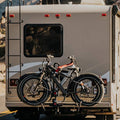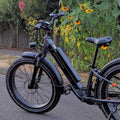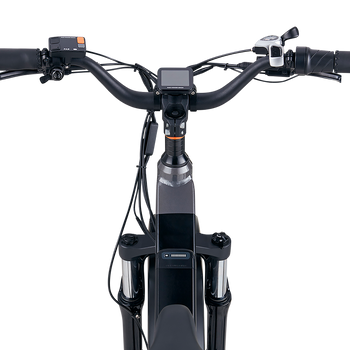This Spring, Ride The Ebike Wave To The Beach

It's almost spring! We bet you can't wait to wake up early, stoked on the anticipation of an early morning surf. You'll take that last sip of coffee and set off on your electric cargo bike, surfboard strapped to the side.
After scanning the horizon, you'll realize it’s completely flat -- no waves as far as the eye can see. But this isn't your first rodeo. You'll know that 3 miles down the coast is another surf spot, and it's only accessible by foot or bike.
Or, of course, an ebike!
Luckily, it’s never been so fun -- and efficient -- to enjoy the warm weather.
Be it dawn patrol, accessing a new area, or having an everyday sandy adventure, there's no better way to get around the beach than by ebike. Sand increases resistance, and in turn, the amount of power needed to move. While riding in sand makes for a great workout, electric bikes with pedal assistance make beach riding all the more practical.
But preparation is key. Sand and salt are not generally kind to metallic and electrical components, and pristine beaches can spell treachery for the rider -- and devastation for your ebike -- if you don't know what you're getting into.

With proper knowledge, maintenance, and care, you can avoid disaster. Here are some pro tips from our resident experts to keep in mind when riding on the beach:
1. Sand Looks Great On The Beach, But Not All Over Your Bike.
After every ride, inspect your bike for saltwater or sand and remove any buildup with a damp or dry rag. Avoid cleaning your ebike with a hose or pressure washer, as direct water pressure can damage certain electrical components. Using direct water pressure with sand and salt can also spread those particles to other areas as well. Never ride in standing saltwater or brackish water because, you know, back spray, man!
2. Be Cool To Your Chain.
Keep your chain lubricated, but don't lubricate it right before a sandy or salty ride. Instead, after your ride, clean the chain off and apply a chain lubricant and let it settle for about two hours before going back into the sand. We recommend a Teflon lubricant, as it will apply wet then dry over time. A wet chain will attract unwanted sand and salt buildup.
When it comes to lubrication, it is also important to lubricate the sprockets. It may be easier to put the lube on a cloth and the cloth on the sprockets as you turn the pedals. Make sure to lubricate the nipples of the spokes on your wheels in a similar fashion.
3. Pack Sunscreen For You And Essentials For Your Bike.
Keep extra tires and tubes nearby, as sand and salt can wear these down more quickly than another terrain, and there can often be sharp objects in the sand like shells and glass, which can easily puncture a tire.
And speaking of tires, it can be helpful to lower the pressure to help make maneuvering through sand easier. Make sure to bring the PSI back up to at or near 20 (assuming a fat tire bike) before you get back on a hard surface, as low tire pressure on pavement will increase the likelihood of a pinch flat.
4. Surfs Up? Tune-Up!
If you ride sand often, you will need to maintain your bike more regularly. If you normally have your bike serviced twice a year, double down -- at least. It's also recommended that you do a drivetrain cleaning when you do a tune-up. This entails taking the components of the drivetrain apart to remove any unwanted sand. This should be done by professionals who are familiar with electric bike components.
Make sure to check your headset bearings often, as sand can sneak into tight areas. Bottom bracket maintenance, including cleaning, removing, and greasing the threads and inner bottom bracket shell is recommended.
All your components will go through added wear and stress when exposed to sand and salt. Keep a closer eye on all moving parts and replace them when they're showing signs of wear. For instance, particles like sand, dirt, and salt will increase the likelihood of chain stretch (which can damage the freewheel and cogs), so replacing your chain is a good idea.
Some other rules of thumb:
Be aware of local laws.
Many beaches across the U.S. do not allow bikes or motorized vehicles of any type. If you are unclear about the rules in your area, reach out to your local government or law enforcement office.
Be considerate.
When riding along or near the beach, avoid biking near children or crowds. Riding in more remote areas will decrease the likelihood of accidents.
Know your sand.
Riding hard-packed sand is recommended over loose or deep sand, as it will allow the rider to maintain full control of the bike. Loosely packed or deep sand is only advised if you have wider tires. Keep as much weight over your rear tire as possible, keep a looser grip on your bars, and sit back, relax, and have fun!
Don't have a bike to ride on the beach? Fear not! Many coastal towns have rental shops. Check out some of the rental fleets that Rad Power Bikes works with!







